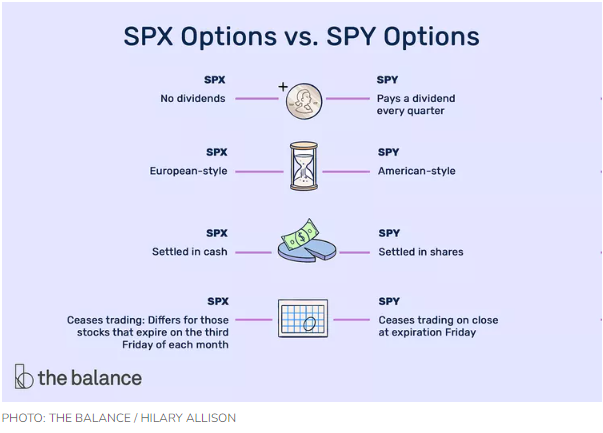
What's the Difference Between SPX and SPY Options?
What Is SPX?
SPX is the S&P 500 index, which is a stock market index that measures the performance of 500 large cap publicly traded companies in the United States. The S&P 500 index is widely regarded as one of the best measures of the overall performance of the U.S. stock market.
SPX is a numerical value that represents the level of the S&P 500 index. It is calculated by taking the weighted average of the stock prices of the 500 companies included in the index, with the weights determined by the market capitalization of each company. SPX is often used as a benchmark for the performance of large cap U.S. stocks.
The S&P 500 index is maintained by S&P Dow Jones Indices. It is one of the most widely followed stock market indices in the world and is used as a benchmark by investors, analysts and financial professionals.
What Is SPY?
The SPDR S&P 500 ETF Trust (SPY), also known as SPY, is an exchange-traded fund that tracks the performance of the S&P 500 index. The S&P 500 is a stock market index that measures the performance of 500 large cap publicly traded companies in the United States.
SPY was introduced in 1993 and is one of the oldest and largest ETFs in the world, with over $375 billion in assets under management as of May 1, 2023. SPY trades on the NYSE Arca exchange and can be bought and sold like a stock through a brokerage account.
Investing in SPY provides investors with exposure to a diversified portfolio of large cap U.S. stocks, making it a popular choice for those looking to invest in the U.S. stock market. Because it tracks the S&P 500 index, SPY is often used as a benchmark for the overall performance of the U.S. stock market.
Dividends
Dividends are not normally paid to options holders. However, SPY pays a dividend every quarter. This is vital because if you trade with in-the-money (ITM) call options, you can exercise them to collect the dividend. To do this, you need to exercise your options on SPY before the ex-dividend date or own shares and place a call (called a covered call option).
It is important to be alert when trading ITM calls because most calls are exercised for the dividend on expiration Friday. Therefore, if you own these options, you cannot afford to lose the dividend.
The ex-dividend day for SPY is the third Friday of March, June, September, and December. If that day doesn't fall on a business day, it is pushed to the next business day.
Trading Style
There are two different trading styles, European and American. European style options can only be exercised on the expiration date, while American options can be exercised any time before the expiry date.
SPY options are American-style and may be exercised at any time after the trader buys them (before they expire).
Expiration
SPX options that expire on the third Friday stop trading the day before the third Friday (the third Thursday). On the third Friday, the settlement price is determined by the opening prices of each of the index's stocks. This price is the closing price for the expiration cycle. SPY options cease trading at the close of business on expiration Friday.
Note
All SPX options expire at the close of business on expiration Friday. However, those that expire on the third Friday of the month do not.
Settlement
SPY options are settled in shares. When you exercise your options, you'll buy (or sell) shares of the ETF. Cash is used to settle SPX options, so if you exercise and are in the money, you'll receive cash in your brokerage account.
Value
An SPX option is also about 10 times the value of an SPY option. For example, on April 9, 2020, SPX closed at 2,789.82 points, and SPY closed at $278.20.34
It's vital to grasp that one SPX option with the same strike price and expiration is approximately 10 times the value of one SPY option. Therefore, each SPX point was the same as $100.5
For example, suppose SPX was at 2,660 points, and SPY traded near $266. One in-the-money SPX option gives its owner the right to buy $266,000 worth of the underlying asset ($100 x 2,660).
One SPY option gives its owner the right to buy $26,600 worth of ETF shares (10% of $266,000).
Liquidity
SPY has very "tight" bid/ask spreads. This helps planning because one has a pretty could idea of the execution price. It also enables the use of market orders which are easier and can execute much quicker than limit orders. When using market orders, many brokers (I know Fidelity does) offer price improvements that can result in favorable execution prices.
SPX, on the other hand, has a relatively wide bid/ask spread when compared to SPY. This means that limit orders are a must. That means some "bargaining" with the price and much slower execution. It is more time intensive, less precise and one never really knows if they received the best price.
Some traders prefer ETFs like SPY due to better liquidity. What they often forget is the fact that Index options are 10 times bigger product, so 20 cents spread on RUT is equivalent to 2 cents spread on IWM. For example, spread of 10.00/10.50 on RUT would be equivalent to 1.00/1.05 on IWM. The slippage on RUT is usually no more than 10-15 cents which is 1-1.5 cents on IWM.
Commissions
Buying less contracts means a significant difference in commissions. For example: if you buy one lot of 10 strike SPX Iron Condor, you will trade 8 round trip contracts. At $1/contract, that's $8 or 0.8% of the $1,000 margin. Buy 10 lots of 1 strike SPY Iron Condor - and the commissions jump to $80 or 8% of the $1,000 margin.
Tax Treatment Differences
Here there is a substantial plus to Index options. The IRS treats these indexes differently from stocks (or ETFs).
The Index options get special Section 1256 treatment which enables the investor to have 60% of a gain as long term (at a 15% tax rate), and the other 40% treated as short term (at the regular 35% short term capital gains rate) even if the position is held for less than a year.
By contrast, the ETFs are treated as ordinary stocks, and thus if held less than a year, all gains are taxed at the less favorable 35% short-term capital gains rate.
Thus the Index options can be better from a tax standpoint. You should of course consult with your tax advisor to see how these tax implications may or may not be significant in your situation.
Verdict: SPX tax treatment is significantly better than SPY. SPY has an advantage in LEAPS, but from a practical point of view, it can't even come close to the advantages offered SPX. Remember, it's not what you make it's what you keep that matters.
Which Is Right For You?
The assets within SPX do not trade, so there are no shares available to buy or sell. The options are written so that traders can bet on the S&P 500's price movements. SPX functions as a theoretical index with a price calculated as if it were a true index.
Note
The 500 specific stocks in the index are rebalanced once per quarter in March, June, September, and December.6 You should watch for these times when trading options, as there might be new opportunities to enter and exit positions.
This means it has exactly the number of shares of each of the 500 stocks. So, while the SPX itself may not trade, both futures contracts and options based on the index do. This is why SPX options are settled in cash.
The SPY options are settled in shares because shares are being traded on an exchange. Therefore, the options contracts are written so that you take possession of shares when you exercise your option.
Which options are best for you depends upon your strategy and goals. If you want to take possession of shares to hold or trade again, SPY might work best. If you'd rather trade for value and receive cash in your account, SPX is an excellent choice.
Trading SPY options does bring some additional risk. For example, on the Monday following expiration, you end up owning shares. You'll owe the price of those shares at the expiry time, not the price on Monday. So if the price for the shares moves lower on Monday, you're paying more than they are worth on that day. However, if the price moves higher, you pay less than the current market price.
The Bottom Line

The two key differences between SPY vs. SPX options are that they are either American or European style, and SPY options are on an ETF while SPX options are on the prices of the index itself. You should understand the difference this makes for exercising your options. Additionally, the difference in value (and settlement) makes how much capital you have to buy the options important.
SPX clearly wins the "assignment risk" war, the "trading costs" war and the "taxable account" war. It loses on flexibility and convenience. For those that trade options in IRAs and ROTHs, SPX should be very seriously considered. Sometimes it's better to pay a little and NOT be sitting on a time-bomb.
For those with taxable accounts the tax advantages afforded SPX dwarfs any increase in costs. In the end it comes down to one's willingness to spend extra time and effort to achieve tax savings..
If you have more capital to spare and don't require dividends, SPX might be a good choice. On the other hand, SPY might be a better choice if you're a bit short on funds and can use the dividends.
Mark Wolfinger has been in the options business since 1977, when he began his career as a floor trader at the Chicago Board Options Exchange (CBOE). Since leaving the Exchange, Mark has been giving trading seminars as well as providing individual mentoring via telephone, email and his premium Options For Rookies blog. Mark has published four options trading books. His Options For Rookies book is a classic primer and a must read for every options trader. Mark holds a BS from Brooklyn College and a PhD in chemistry from Northwestern University.
Related articles



There are no comments to display.
Join the conversation
You can post now and register later. If you have an account, sign in now to post with your account.
Note: Your post will require moderator approval before it will be visible.